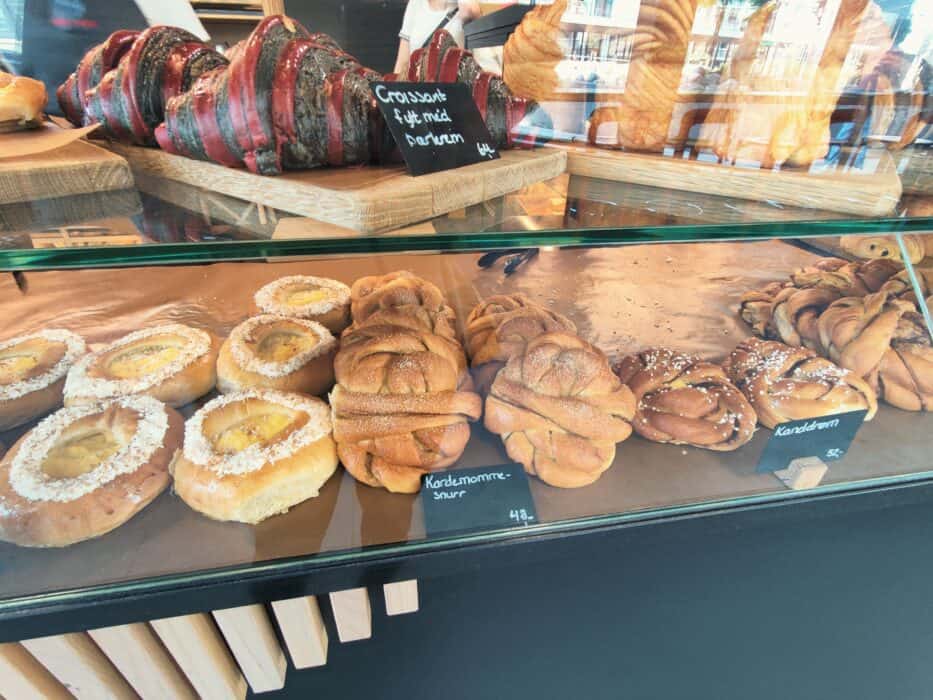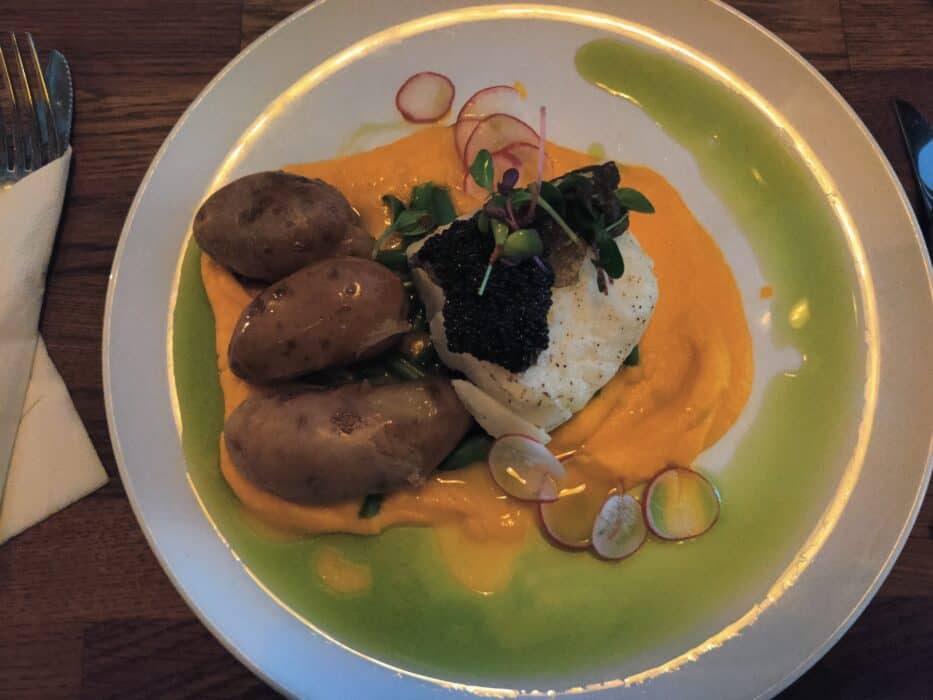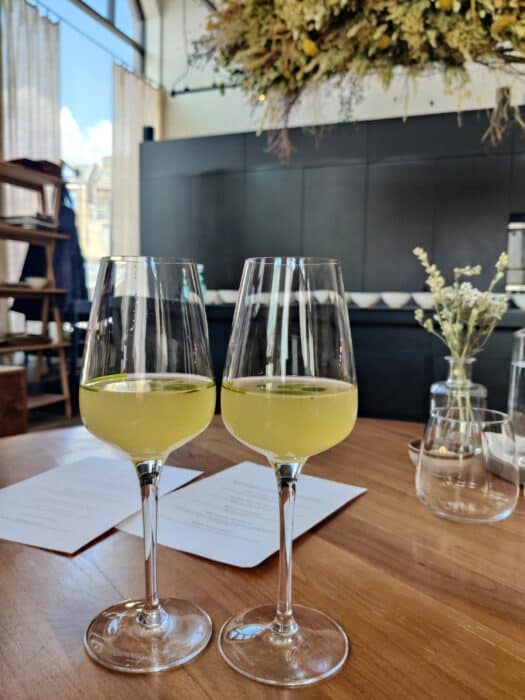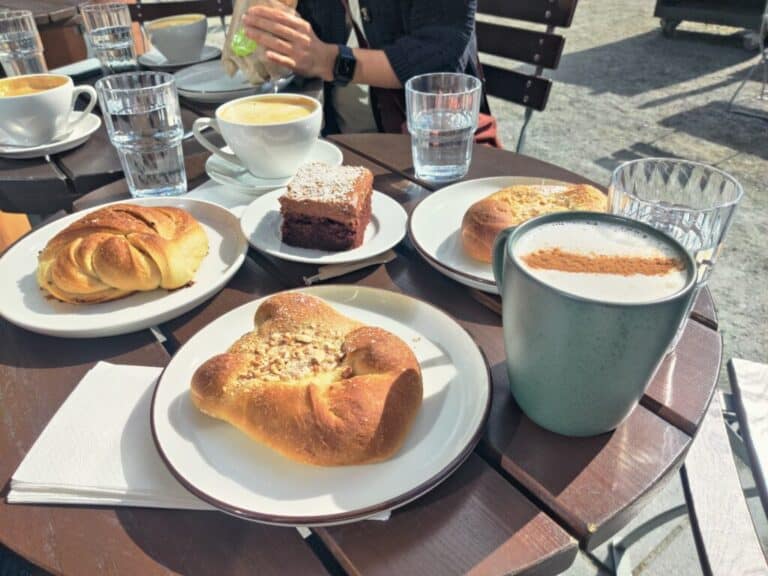Cost of Food in Norway: A Guide to Food and Drink Prices
Disclaimer: This post may contain affiliate links, which means I may earn a small commission if you make a purchase at no additional cost to you. I only recommend products and services that I would use myself and all opinions expressed here are my own. You can read my full privacy policy here.
Planning a Norway trip? Norway with high wages and a strong currency, is one of the most expensive countries in the world and naturally, as a traveler the cost of food in Norway can be a significant expense and travel cost.
Eating out in Norway as well as buying food and snacks can all add up quickly. As a traveler and self proclaimed foodie, this guide to food prices in Norway is based on my own recent trips to Norway.
My first trip where spent mostly eating out and the second trip where was spent on a road trip hiking across the country and hence mostly buying groceries from supermarkets in Norway.
The below post will provide a guide to food prices in Norway, including Norway food prices for restaurants, cafes, bars and common groceries items. All prices are noted in Norwegian Krone and US dollars.
Daily Food Budget in Norway
Shoestring €20–30/day · Sensible €35–55/day · Comfortable €60–80/day
(includes groceries + 1 meal out)
Compare hotel prices in Oslo (with breakfast included) →
Book a Norweigan dinner and cruise tour →

Why is Food so Expensive in Norway?
Living in Norway is pretty expensive, especially when it comes to food. The consumer price index (CPI) shows that costs are high across the board, thanks to strong wages and a solid economy. Norway’s living index is one of the highest in the world, which means day-to-day expenses like groceries and eating out can really add up. A lot of this comes down to things like high taxes, import costs, and strict regulations, so you’ll find that food prices here are noticeably steeper than in many other countries.
Ready to Plan Your Norway Trip?
Average Cost of Food in Norway
The below is a breakdown of the average cost of eating out food in Norway (reflecting prices as of 2024). Ofcourse, food costs will differ slightly based on each city and town, however the below in an indicative guide.
Want the full grocery breakdown? See supermarket prices in Norway here →
Restaurant Prices in Norway
Here is what you can typically expect to pay for food in restaurants in Norway:
Fast food / street food meal: 120 NOK -150 NOK ($12-15/ £9.60-12)
Casual café meal: 150-250 NOK ($15-25/ £12-20)
Mid-Range Meal: Three-course meal for two at a mid-range restaurant: 700-1200 NOK ($70-120/ £56-96)
High-End Dining: Fine dining/ upscajle restaurant: 1200-2500 NOK ($120-250/ £96-200) per person
Tip: Many hotels include breakfast buffets in the rate. Compare hotel deals in Oslo with breakfast included →
How much in does a typical breakfast cost in Norway?
Berakfast is probably my favourite meal in Norway, because of the vast and mouthwatering choice of breakfast pastries you will find in most cafes and coffee shops. Some indicative prices for Norweigan breakfast items are:
- Coffee or Tea: 30 – 45 NOK ($3–$4.50/ £2.40-3.60)
- Pastry (like a croissant): 30 – 50 NOK ($3–$5/ £2.40-4)
- Sandwich or light meal: 80 – 150 NOK ($8–$15/ £6.40-12)
- Full Norwegian breakfast buffet: 150 NOK – 250 NOK ($15–$25/£12-20)
- Breakfast in a café or restaurant: 100 NOK – 200 NOK ($10–$20/£8-16)
These are averages only, and I have found prices to be higher in central tourist areas (such as in Oslo and Bergen) and at hotels.
Handy tip: bakeries like Godt Brød often have early-bird discounts. Go before 10am for cheaper pastries and coffee.
Cost of Lunch/ Dinner in Norway
The price range for lunch and dinner in Norway can vary widely based on the type of restaurant and city, with Oslo, Bergen and Tromso all being slightly more expensive than smaller towns and cities.
- Light meal / sandwich: 100 NOK to 150 NOK
- Main dish at a mid-range restaurant: 200–400 NOK ($20–$40/ £16-32)
- Seafood or steak dish at a higher-end restaurant: 300–600 NOK ($30–$60/ £24-28)
- Three-course meal at a higher end restaurant: 500–1,000 NOK ($50–$100/ £40-80)
- Pizza or pasta at a casual restaurant: 150–250 NOK ($15–$25/ £12-20)
- Beer (1 pint) in a restaurant or bar: 90–130 NOK ($9–$13/ £7.20-10.40)
- Glass of wine in a restaurant: 100–150 NOK ($10–$15/ £8-12)
When you eat out, don’t worry about extra charges: service is included. Read my full guide to tipping in Norway →

Cost of Typical Norwegian Dishes
Lutefisk – Dried fish (usually cod) that has been soaked in a lye, rehydrated, and cooked, resulting in a gelatinous texture, trust me this is better than it sounds. Typically served with potatoes and peas.
Cost
250-400 NOK ($25-40/ £20-32) at mid-range restaurants
400-600 NOK ($40-60/ £32-48) at high-end restaurants.
- Kjøttkaker: Meatballs made from a mixture of ground beef and pork, served with brown gravy, boiled potatoes, peas, and lingonberry jam.
Cost
150-250 NOK ($15-25/ £12-20) at mid-range restaurants
250-400 NOK ($25-40/ £20-32) at high-end restaurants. - Reindeer Steak: A tender and flavorful cut of meat from reindeer, often grilled or pan-fried, and served with root vegetables and a rich sauce.
Cost: 300-500 NOK ($30-50/ £24-40) at mid-range restaurants, 500-800 NOK ($50-80/ £40-64) at high-end restaurants. - Rakfisk: Thai is a type of fermented fish, usually trout, traditionally eaten with flatbread, sour cream, onions, and potatoes.
Cost: 200-350 NOK ($20-35/ £16-28) at mid-range restaurants, 350-500 NOK ($35-50/ £28-40) at high-end restaurants. - Bacalao: Is a salted cod stew with tomatoes, onions, and olives, often served with potatoes.
Cost: 200-350 NOK ($20-35/ £16-28) at mid-range restaurants, 350-500 NOK ($35-50/ £28-40) at high-end restaurants.
Cost of Typical Norweigan Pastries and Desserts
- Kransekake (almond ring cake): A slice of this at a cafe would cost Slice at a cafe would cost about 50-80 NOK ($5-8/ £4-6.40)
- Skillingsboller (cinnamon bun): At a bakery or café this would typically cost 30-50 NOK ($3-5/ £2.40- 4). I personally recommend the Cardamom bun over the Cinnamon bun, but you will find both in plenty of bakeries around Norway!)

Cost of Grocery Items in Norway in USD and GBP
Grocery shopping is a smarter choice if you’re traveling on a budget, but even then, you’ll notice that Norway’s expensive reputation holds true.
Below is the cost of some typical grocery items in supermarkets across Norway.
- Milk (1 liter): 20-25 NOK ($2-2.50/ £1.60-2)
- Bread (500g loaf): 25-35 NOK ($2.50-3.50/ £2-2.80)
- Eggs (12): 35-50 NOK ($3.50-5/ £2.80-4)
- Cheese (1 kg): 100-150 NOK ($10-15/ £8-12)
- Chicken breast (1 kg): 120 – 180 NOK ($12-18/ £9.60-14.40)
- Apples (1 kg): 30-45 NOK ($3-4.50/ £2.40-3.60)
- Potatoes (1 kg): 20-30 NOK ($2-3/ £1.60-2.40)
Pro tip: Coop and Rema 1000 often have discount shelves in the evenings. You’ll save up to 40% on same-day items.
See my full Norway supermarket prices guide →
Alcohol Prices in Norway in USD and GBP
When talking about the cost of food in Norway, it’s impossible not to mention alcohol given it can be notoriously expensive here. Whether you’re dining out or grabbing a drink from a bar, expect to pay a premium.
The only exception to this is if you buy alcohol from the state-run Vinmonopolet stores, which can be a more affordable option than drinking out. Nonetheless, below is a guide to the typical prices for wine, beer and alcoholic drinks when drinking out in Norway.

A night out in Norway is not cheap! But the prices can vary hugely depending on the type of venue and bar and city, with Oslo and Bergen being the most expensive.
Cost of Wine in Norway
Wine by the glass
Mid-range wine: 80 -120 NOK ($8-12/ £6.40-9.60) per glass.
Higher-end: 120 – 180 NOK ($12-18/ £9.60-14.40) per glass.
Bottle of wine (mid-range):150 – 300 NOK ($40-80/ £32-64) at a bar or restaurants
Cost of Beer in Norway
Average 1 pint in a bar
Standard prices: 90-130 NOK ($9-13/ £7.20-10.40)
However, this can vary, with imported craft beers costing signficantly more
Domestic Lager: 90 – 130 NOK ($9 – $13 / £7.20-10.40)
Imported Lager: 100 – NOK ($10–$15 / £8-12)
Craft Beer: 120 – 200 NOK ($12–$20 / £9.60-16)
Cost of Coffee in Norway
Coffee at a café: 30-50 NOK ($4-6 / £3.20-4.80)
Bottled water: 20-30 NOK ($2-3 / £1.60-2.40)

Cost of Traditional Norweigan Drinks
Akvavit is a traditional Scandinavian spirit that is infused with herbs and spices like caraway and dill, typically enjoyed as a shot during festive occasions or with traditional meals. This is one that a lot of the locals recommend, but I personally think its an acquired taste!
Cost: 90-150 NOK ($9-15 / £7.20-12)
Kaffekarsk – A traditional coffee drink mixed with moonshine or vodka.
Cost: Depends on the cost of the coffee and spirits used, but typically around 50-100 NOK ($5-10/ £4-8) per serving when made at home.
Gløgg – A traditional Norwegian mulled wine, especially popular during Christmas and must try at Norwegian Christmas markets!
Homemade: Ingredients cost around 100-200 NOK ($10-20/ £8-16) for a batch.
Pre-made in stores: 50-100 NOK ($5-10 / £4-8) for a bottle.
Average Daily Cost of Food in Norway
The below are average costs spend on food in a day, assuming you eat out all 3 meals – breakfast, lunch and dinner.
Budget to Mid Range Traveler
Breakfast – Café breakfast (e.g., coffee and pastry): 50 – 80 NOK ($5-8 / £4-6.40)
Lunch – Mid range restaurant (e.g., soup, salad, or main course): 150 NOK – 250 NOK ($15-25 / £12-20)
Dinner Mid range restaurant (e.g., two-course meal) – 250 NOK – 400 NOK ($25-40 / £20-32)
Total per day: 450-730 NOK ($45-73/ £36-58.40)
High-Range Traveler
Breakfast at a Hotel or a upscale café breakfast: 80-150 NOK ($8-15 / £6.40-12)
Lunch at a fine dining restaurant (e.g., three-course meal): 300-500 NOK ($30-50/ £24-40)
Dinner: High-end restaurant (e.g., gourmet meal): 500-800 NOK ($50-80 / £40-64)
Total per day: 880-1450 NOK ($88-145 / £70.40-116)
Is Tipping Expected in Norway?
The good news in that tipping is not customary in Norway, nonetheless you are always welcome to leave tips for exceptional service.
So when you typically see prices on restaurant menus, this is typically the final price you will end up paying on the final bill, no additional taxes or tips on top.

Check my Guide on Tipping Practises in Norway for everything you need to know about tipping while visiting Norway
Cost of Food in Oslo v Cost of Food in Bergen
The cost of food in Norway varies across different regions and cities, influenced by local economies and levels of tourism. Oslo, as the capital, is the most expensive, with high prices for dining out and groceries. Bergen and Stavanger also have high costs. I found this to be especially the case in tourist-heavy and central areas, such Bergen harbour frequented by large tourist cruise ships.
I found that smaller towns and rural areas offer slightly lower prices, though still high by international standards, with fewer high-end dining options but more affordable local eateries. In Northern Norway, such as Tromsø, food costs are slightly higher than in southern cities. Quite possibly be because the north of Norway is technically even more remote than the Southern Norweigan cities.

How to Budget for Food in Norway
Traveling in Norway can be expensive, but there are several strategies you can use to save money on food. Here are some tips:
1. Cook Your Own Meals
- Accommodation with Kitchens: Opt for accommodations that include kitchen facilities
- While we almost booked a hotel in Bergen because it was cheaper on Booking.com, we realised it was actually more economical to book somewhere slightly more expensive with a kitchen, because making a few of our own meals would actually save us significant money over a few days.
- Grocery Stores: I found these are the most common grocery stores in central areas in most Norwegian cities – Rema 1000, Kiwi, or Coop.
2. Eat Like a Local
- Local Markets: Visit local markets for fresh and often cheaper produce. Farmers’ markets can be a great place to find affordable and high-quality food. Having recently visited the Bergen Fish Market, I would highly recommend visiting here for the fresh seafood!
- Traditional Foods: Some traditional Norwegian foods, like brunost (brown coloured local cheese) and flatbrød (flatbread), are relatively inexpensive and widely available. I have to say I was not a fan of brown cheese, but having tried a few different versions now, I can say some are definitely better than others. Personally I’ve found brown cheese in block version somehow just tastes better than the pre-sliced one!
- For a classic Norweigan feast, consider booking a Norweigan dinner and cruise tour →
3. Lunch Specials
- Midday Deals: Many restaurants offer lunch specials, which are significantly cheaper than dinner menus. Look for “dagens rett” (dish of the day) for the best deals.
- Buffets: Some places offer buffet-style meals, particularly for lunch, which can be a cost-effective way to eat out.
4. Fast Food and Street Food
- Affordable Options: Consider fast food chains, local kebab shops, or street food vendors for a cheaper meal option. A hot dog (pølse) from a convenience store can be a quick and inexpensive meal.
- Bakery Goods: Bakeries often sell affordable pastries, sandwiches, and buns that can serve as a meal or a snack.
How to Spend Less (Without Feeling Miserable)
- Shop at Rema 1000 or Kiwi — cheapest chains.
- Grab bakery lunches (skillingsboller + coffee = filling meal).
- Drink tap water (safe, excellent quality).
- Look for dagens rett (dish of the day) at lunch — better value.
- Book one of these hotels with kitchens to cook dinners.
See current supermarket prices & saving tips – Supermarket Prices in Norway →
Norway Cost of Living versus UK Cost of Living
As someone traveling from the UK to Norway for a few trips, I was curious to compare the cost of living in Norway versus the cost of living in UK. Overall I would note that as of 2025 the cost of living in Norway is significantly higher than in the UK, with more expensive housing, cost of groceries, dining, and public transport overall.
There are higher taxes and utility costs in Norway, though they support excellent public services, including healthcare. While the UK remains more affordable, especially outside London, rising costs in housing, utilities, and transport are becoming increasingly noticeable in major cities.
A vacation in Norway is entirely possible whilst enjoying its culinary delights without breaking the bank. Just make sure to plan ahead by choosing accommodation with kitchens and grocery stores nearby.
Explore local markets and street food for traditional dishes like pølse and fiskekaker, and take advantage of lunch specials and discounts. Balance dining out with cooking simple meals, and visit specific famous food spots for an authentic experience.
Final Tips on Eating in Norway
- Grocery shopping saves money and lets you try local food like brunost.
- Prices are highest in Oslo & Bergen harbors (cruise crowds).
- Small towns = cheaper meals, but fewer options.
- Lunch deals are Norway’s best-kept secret — look for them.
Ready to Plan Your Norway Trip?
- Compare hotels in Oslo & Bergen →
- Book a Norweigan dinner and cruise tour →
- Check supermarket prices in Norway →
MY GO-TO TRAVEL PLANNING RESOURCES FOR NORWAY
Flights
I always start my flight search with Kiwi.com or Google Flights to compare prices, set alerts, and find the best deals. But if there is a minimal price difference, I tend to go directly with the airline—it’s often worth the extra peace of mind if anything changes.
Trains & Public Transport
For Norway and other European trips, I use Trip.com and Omio to compare train prices, or I book directly with local rail operators in some countries like Trenitalia (Italy) and SNCF (France). If I’m doing a multi-country trip, I’ll see if a Eurail Pass makes sense. For metro, buses, and ride-shares, Google Maps + Citymapper are great for navigation.
Accommodation
My first stop is always Booking.com—it has flexible cancellation policies and a huge selection. If I want a longer stay or a more local experience, I check Airbnb next. For boutique hotels, I’ve used Booking.com again or Tablet Hotels.
Activities & Experiences
I browse GetYourGuide, Viator, and Klook for curated tours, especially in places where having a local guide makes a big difference. Otherwise, my go-to research method is a mix of Google searches, travel blogs, and local recommendations—sometimes the best experiences aren’t bookable online!
Travel Money & Cards
I swear by Wise for international spending—it has low fees, great exchange rates, and multi-currency accounts that make travel super smooth. For backup, I have a Monzo card which lets you take out a set amounts at overseeas ATMS without fees.
Travel Insurance
Travel insurance is a must. EKTA is good standard insurance with add ons for adventure actvities. SafetyWing for long-term travelers or digital nomads. Its always reading the fine print to make sure your activities are covered!
Luggage & Packing
For my short haul trips from London to Europe I mostly have a basic carry on only for which I use IT Luggage. I like that it makes some of the lightest suitcases by weight, which is ideal if you’re operating with strict weight restrictions on budget airlines. For longer trips, Away Bigger Carry-On is good for a spacious, sleek, and lasting luggage bags.
Are you heading to Norway?
Check out our other guides on Northern Lights, Norweigan winter itineraries and more practical travel tips!
10 Day Winter Norway Itinerary: Northern Lights and Beyond
Tipping in Norway: Do You Tip In Norway as a Tourist?
Bergen Fish Market – Ultimate Guide to Visiting
Prices in Oslo: Is Oslo Expensive to Travel to?
Supermarket Prices in Norway in 2024 – A Comprehensive Guide

